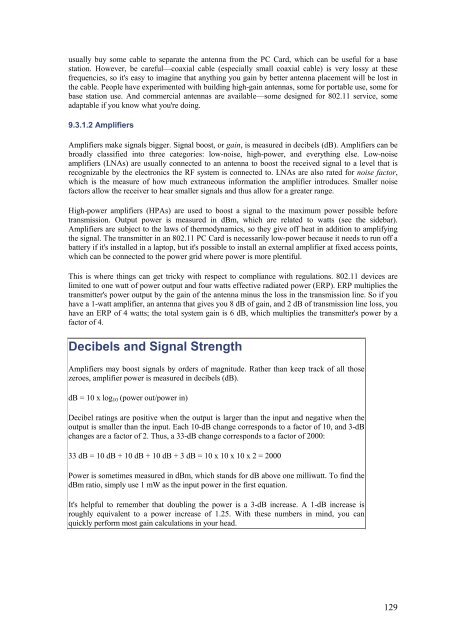Wireles Networks The Definitive Guide.pdf - Csbdu.in
Wireles Networks The Definitive Guide.pdf - Csbdu.in
Wireles Networks The Definitive Guide.pdf - Csbdu.in
Create successful ePaper yourself
Turn your PDF publications into a flip-book with our unique Google optimized e-Paper software.
usually buy some cable to separate the antenna from the PC Card, which can be useful for a base<br />
station. However, be careful—coaxial cable (especially small coaxial cable) is very lossy at these<br />
frequencies, so it's easy to imag<strong>in</strong>e that anyth<strong>in</strong>g you ga<strong>in</strong> by better antenna placement will be lost <strong>in</strong><br />
the cable. People have experimented with build<strong>in</strong>g high-ga<strong>in</strong> antennas, some for portable use, some for<br />
base station use. And commercial antennas are available—some designed for 802.11 service, some<br />
adaptable if you know what you're do<strong>in</strong>g.<br />
9.3.1.2 Amplifiers<br />
Amplifiers make signals bigger. Signal boost, or ga<strong>in</strong>, is measured <strong>in</strong> decibels (dB). Amplifiers can be<br />
broadly classified <strong>in</strong>to three categories: low-noise, high-power, and everyth<strong>in</strong>g else. Low-noise<br />
amplifiers (LNAs) are usually connected to an antenna to boost the received signal to a level that is<br />
recognizable by the electronics the RF system is connected to. LNAs are also rated for noise factor,<br />
which is the measure of how much extraneous <strong>in</strong>formation the amplifier <strong>in</strong>troduces. Smaller noise<br />
factors allow the receiver to hear smaller signals and thus allow for a greater range.<br />
High-power amplifiers (HPAs) are used to boost a signal to the maximum power possible before<br />
transmission. Output power is measured <strong>in</strong> dBm, which are related to watts (see the sidebar).<br />
Amplifiers are subject to the laws of thermodynamics, so they give off heat <strong>in</strong> addition to amplify<strong>in</strong>g<br />
the signal. <strong>The</strong> transmitter <strong>in</strong> an 802.11 PC Card is necessarily low-power because it needs to run off a<br />
battery if it's <strong>in</strong>stalled <strong>in</strong> a laptop, but it's possible to <strong>in</strong>stall an external amplifier at fixed access po<strong>in</strong>ts,<br />
which can be connected to the power grid where power is more plentiful.<br />
This is where th<strong>in</strong>gs can get tricky with respect to compliance with regulations. 802.11 devices are<br />
limited to one watt of power output and four watts effective radiated power (ERP). ERP multiplies the<br />
transmitter's power output by the ga<strong>in</strong> of the antenna m<strong>in</strong>us the loss <strong>in</strong> the transmission l<strong>in</strong>e. So if you<br />
have a 1-watt amplifier, an antenna that gives you 8 dB of ga<strong>in</strong>, and 2 dB of transmission l<strong>in</strong>e loss, you<br />
have an ERP of 4 watts; the total system ga<strong>in</strong> is 6 dB, which multiplies the transmitter's power by a<br />
factor of 4.<br />
Decibels and Signal Strength<br />
Amplifiers may boost signals by orders of magnitude. Rather than keep track of all those<br />
zeroes, amplifier power is measured <strong>in</strong> decibels (dB).<br />
dB = 10 x log 10 (power out/power <strong>in</strong>)<br />
Decibel rat<strong>in</strong>gs are positive when the output is larger than the <strong>in</strong>put and negative when the<br />
output is smaller than the <strong>in</strong>put. Each 10-dB change corresponds to a factor of 10, and 3-dB<br />
changes are a factor of 2. Thus, a 33-dB change corresponds to a factor of 2000:<br />
33 dB = 10 dB + 10 dB + 10 dB + 3 dB = 10 x 10 x 10 x 2 = 2000<br />
Power is sometimes measured <strong>in</strong> dBm, which stands for dB above one milliwatt. To f<strong>in</strong>d the<br />
dBm ratio, simply use 1 mW as the <strong>in</strong>put power <strong>in</strong> the first equation.<br />
It's helpful to remember that doubl<strong>in</strong>g the power is a 3-dB <strong>in</strong>crease. A 1-dB <strong>in</strong>crease is<br />
roughly equivalent to a power <strong>in</strong>crease of 1.25. With these numbers <strong>in</strong> m<strong>in</strong>d, you can<br />
quickly perform most ga<strong>in</strong> calculations <strong>in</strong> your head.<br />
129















